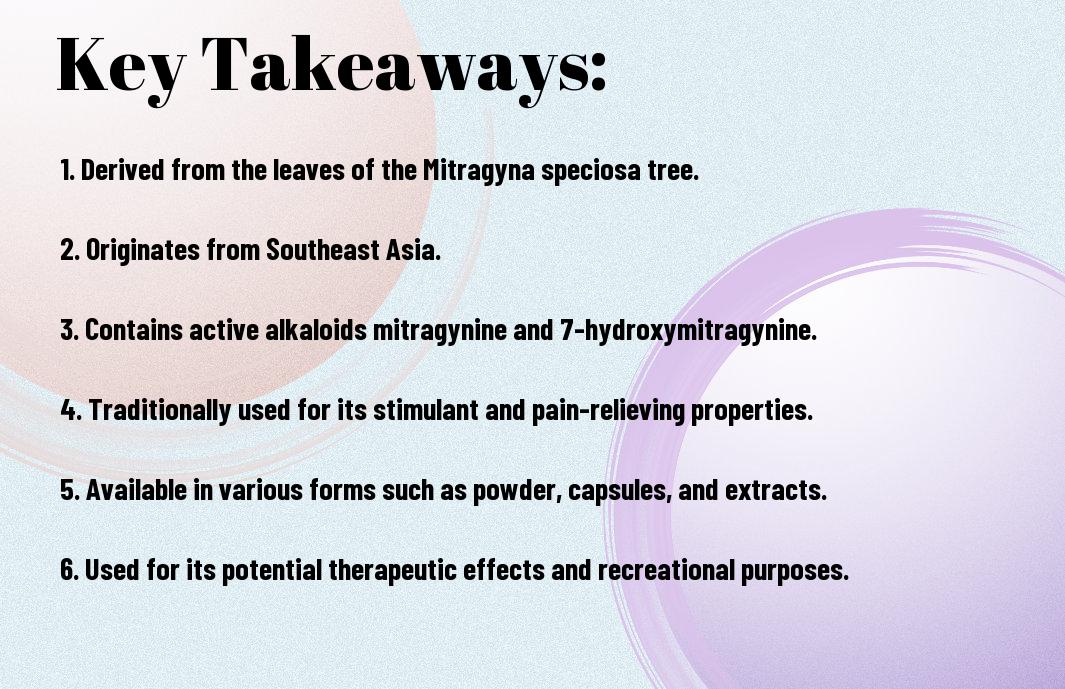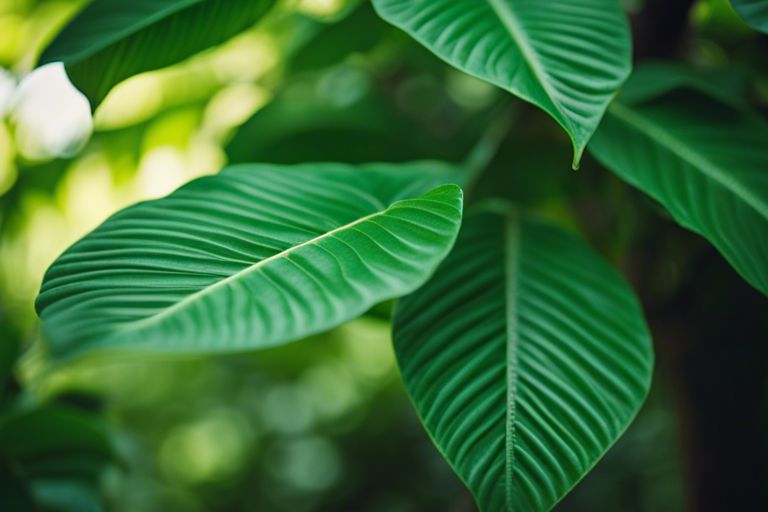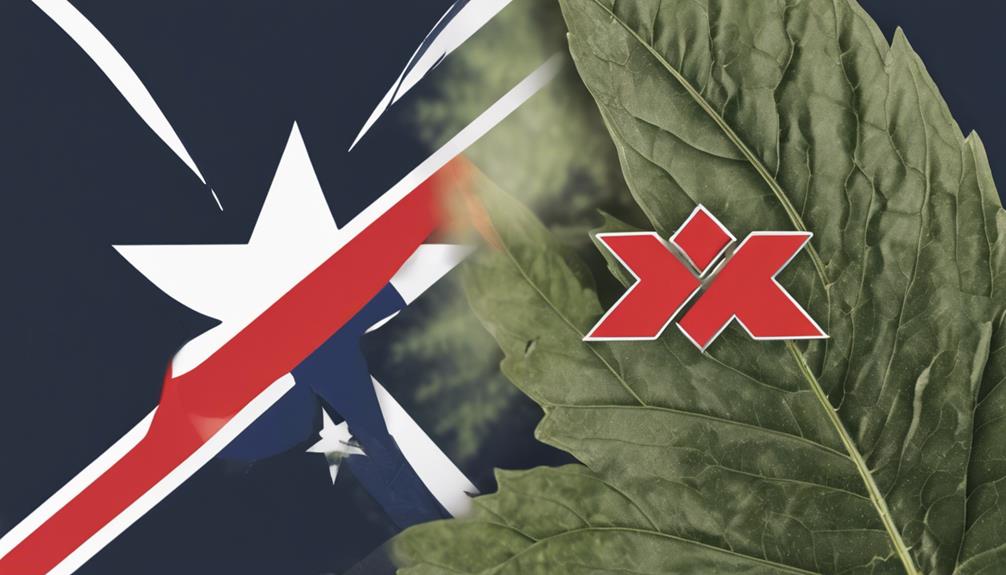Deprecated: mb_convert_encoding(): Handling HTML entities via mbstring is deprecated; use htmlspecialchars, htmlentities, or mb_encode_numericentity/mb_decode_numericentity instead in /home/users/kratomfiles/www/kratomfiles.com/wp-content/plugins/quick-adsense-reloaded/includes/template-functions.php on line 3552
Speciosa Mitragyna, better known as Kratom, originates from the leaves of a tropical tree native to Southeast Asia. The plant-based substance has gained popularity for its potential medicinal properties, offering a range of effects from pain relief to boosted energy. Understanding what Kratom is made from can shed light on its controversial nature and its growing popularity in Western cultures.
Key Takeaways:
- Kratom is made from the leaves of the Mitragyna speciosa tree: Kratom, a tropical evergreen tree in the coffee family, has leaves that are harvested for their medicinal and recreational properties.
- The active components in Kratom are alkaloids: Mitragynine and 7-hydroxymitragynine are the primary alkaloids found in Kratom, responsible for its effects on the mind and body.
- Kratom can be consumed in different forms: The leaves of the Kratom tree can be chewed, brewed into tea, or processed into capsules, powders, and extracts for various consumption methods.

Origins of Kratom
To learn about the origins of kratom, we must investigate into its rich history and cultural significance. According to Kratom: A Legal Drug That’s Dangerously Addictive, kratom has been used for centuries in Southeast Asia for its medicinal properties and as a stimulant. The plant’s leaves contain compounds that can have both sedative and stimulating effects, leading to its diverse uses in traditional practices.
History of Kratom Use
History reveals that kratom has been consumed by indigenous communities for generations due to its various health benefits. In Southeast Asia, laborers would chew on the leaves to combat fatigue and increase productivity. The cultural significance of kratom also extends to spiritual practices, where it was used in rituals and ceremonies.
Native Regions and Cultivation
It is crucial to understand that kratom is native to countries like Thailand, Indonesia, Malaysia, and Papua New Guinea. In these regions, the plant thrives in tropical climates and rich soil. The cultivation of kratom involves careful harvesting of the leaves, which contain alkaloids responsible for its effects. The leaves are traditionally dried and brewed as tea or chewed for their stimulating properties.
Botanical Composition
If you’ve ever wondered what makes up kratom, you’re not alone. The botanical composition of kratom is a fascinating subject that sheds light on the plant’s origins and properties. Let’s research into the intricate details of the Mitragyna Speciosa tree, the alkaloid content, and the primary active compounds that make up this unique botanical.
Mitragyna Speciosa Tree
For those curious about where kratom comes from, the Mitragyna Speciosa tree holds the answers. This evergreen tree, native to Southeast Asia, is the source of the kratom leaves that have been used for centuries for their potential medicinal benefits. The tree’s lush, green leaves are harvested and processed to create the kratom products that consumers have come to know and love.
Alkaloid Content
Any discussion about kratom’s botanical composition would be incomplete without touching on its alkaloid content. Alkaloids are naturally occurring compounds that contribute to the unique properties of kratom. The primary alkaloids found in kratom leaves are mitragynine and 7-hydroxymitragynine, which are known for their potential effects on the body.
Plus, various other alkaloids, such as speciociliatine and paynantheine, are present in smaller quantities and may also play a role in kratom’s overall effects. It’s important to note that the levels of alkaloids can vary depending on the strain and quality of the kratom product, so it’s vital to choose reputable sources for consistency and potency.
Primary Active Compounds
For those seeking to understand the inner workings of kratom, it’s crucial to explore the primary active compounds that drive its effects. Mitragynine and 7-hydroxymitragynine are considered the powerhouse compounds responsible for kratom’s potential benefits. These compounds interact with the body’s receptors to produce a range of effects, from relaxation to increased focus.
Understanding the botanical composition of kratom, including its Mitragyna Speciosa tree origins, alkaloid content, and primary active compounds, provides valuable insight into this unique botanical. By recognizing the key components that make up kratom, we gain a deeper appreciation for its potential effects and applications.
Harvesting and Processing
Leaf Selection and Drying
The process of harvesting and processing kratom leaves is crucial to preserving their quality and effectiveness. Keep in mind that the selection of leaves at the right maturity stage is imperative for optimal potency. Once the leaves are chosen, they are carefully dried to prevent contamination and ensure the preservation of alkaloids, which are key components responsible for the plant’s effects.
Grinding and Powdering
With the dried leaves at hand, the next step in the processing of kratom involves grinding them into a fine powder. This process is imperative for easier consumption and convenient dosing. The powdered form also enhances the efficacy of kratom as it allows for quicker absorption by the body.
Grinding the leaves into powder helps break them down into smaller particles, making it easier for the body to digest and absorb the beneficial alkaloids present in kratom. This finely powdered form is also ideal for preparing different kratom products like capsules and tablets.
Capsule and Tablet Formation
Processing kratom into capsules and tablets offers a convenient and discreet way to consume this herbal supplement. These forms also provide accurate dosing, making it easier for users to control their intake and experience consistent effects. To ensure the safety and quality of the final products, manufacturers follow strict guidelines and practices during the formation process.
Types of Kratom Products
All kratom products can be categorized into different forms based on how they are processed and packaged. Understanding the various types can help consumers choose the best option for their needs.
| Raw Leaf and Powder | Enhanced and Concentrated Forms |
| Blended and Flavored Products |
Raw Leaf and Powder
Leaf
Kratom in its raw leaf form is harvested from the Mitragyna speciosa tree, dried, and ground into a fine powder. This form is the most traditional way of consuming kratom and allows users to experience the full spectrum of its effects.
Enhanced and Concentrated Forms
Leaf
Kratom products in enhanced and concentrated forms are processed to increase the concentration of active compounds, making them more potent than raw leaf powder. These products are popular among experienced users seeking stronger effects or a more convenient dosing method.
Concentrated kratom products such as extracts and tinctures are highly potent and should be used with caution due to their intensity. These forms are not recommended for beginners or those unfamiliar with kratom effects.
Blended and Flavored Products
Products
Kratom vendors often offer blended and flavored products that combine different kratom strains or add natural flavors to enhance taste. These products cater to users who prefer unique blends or are looking to mask the characteristic taste of raw kratom.
Kratom blends can offer a diverse range of effects by combining multiple strains, providing users with a customized experience based on their preferences. However, it is vital to choose reputable vendors to ensure the quality and safety of blended and flavored kratom products.
After exploring the different types of kratom products available, consumers can make informed decisions based on their preferences and experience levels.
Quality Control and Regulation
Unlike pharmaceutical drugs, kratom is not tightly regulated by government agencies, leading to concerns regarding quality control. Currently, the industry relies on self-regulation and adherence to certain standards to ensure the safety and potency of kratom products.
Industry Standards and Certifications
Quality standards and certifications such as Good Manufacturing Practices (GMP) have been implemented by some kratom vendors to ensure the purity and consistency of their products. Consumers are encouraged to look for vendors who adhere to these standards to minimize the risks associated with consuming kratom.
Contamination Risks and Testing
An
The lack of stringent regulations also raises concerns about contamination risks in kratom products. To address this issue, some vendors conduct third-party testing to identify potential contaminants such as heavy metals, pesticides, and pathogens. Consumers should prioritize purchasing kratom from vendors who provide test results to ensure product safety.
Legal Status and Restrictions
Restrictions on kratom vary by country and region, with some places banning its sale and use due to safety concerns and potential for abuse. In the United States, kratom is legal at the federal level but is banned in a few states and municipalities.
Status As the popularity of kratom continues to grow, there are ongoing debates about how to regulate its production and distribution to ensure consumer safety while maintaining access for those who use it for medicinal or recreational purposes. It is vital for consumers to stay informed about the legal status of kratom in their area to avoid any potential legal consequences.

Potential Impurities and Adulterants
Heavy Metals and Pesticide Residues
To ensure the safety of kratom products, it is crucial to address the potential presence of heavy metals and pesticide residues. Not all kratom is grown and processed under the same standards, making it susceptible to contamination. To mitigate this risk, reputable suppliers conduct rigorous testing to detect and eliminate any traces of heavy metals like lead, arsenic, and mercury, as well as pesticide residues from agricultural practices.
Microbial Contamination and Sterility
Pesticide contamination is another concern when it comes to kratom products. Pesticides used during the cultivation of kratom leaves can leave harmful residues that may pose health risks to consumers. Sterility is necessary to prevent microbial contamination, ensuring that the product is safe for consumption. Reputable manufacturers take extra precautions to maintain a sterile environment during processing and packaging to minimize the risk of microbial contamination.
Fillers and Adulterants
On a less visible note, some kratom products may be adulterated with fillers or other substances to increase volume or potency artificially. This deceptive practice can compromise the purity and safety of kratom products, leading to potential health risks for consumers. It is crucial to source kratom from trusted suppliers who prioritize transparency and quality to avoid exposure to harmful fillers and adulterants.
Summing up
To wrap up, kratom is made from the leaves of the Mitragyna speciosa tree, a plant native to Southeast Asia. These leaves are harvested, dried, and ground into a fine powder, which can be consumed in various ways. This natural substance has been traditionally used for its stimulating and sedative effects, but it has also gained popularity in Western countries for its potential medicinal properties. Understanding where kratom comes from is an imperative part of exploring its uses and effects.
FAQ
Q: What is Kratom Made From?
A: Kratom is made from the leaves of the Mitragyna Speciosa tree, which is native to Southeast Asia.
Q: How are Kratom Leaves Processed to Make Kratom?
A: After harvesting, Kratom leaves are dried and ground into a fine powder or processed into capsules or extracts for consumption.
Q: What are the Key Components of Kratom?
A: Kratom contains active compounds called alkaloids, with mitragynine and 7-hydroxymitragynine being the most prevalent and pharmacologically significant.
Q: How is Kratom Used Traditionally?
A: In Southeast Asia, Kratom has been used for centuries for its stimulant and pain-relieving properties, often brewed into tea or chewed raw.
Q: Are There Different Strains of Kratom?
A: Yes, Kratom comes in various strains, such as Red Vein, Green Vein, and White Vein, each with slightly different effects due to varying alkaloid concentrations.










